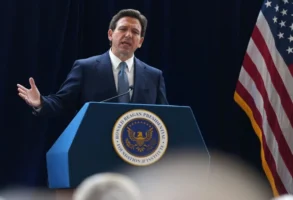
Published September 24, 2020
Our schools have buried the glory and beauty of America’s story under a mountain of misplaced guilt and tendentious ideology. Yes, there are faults in our story — the stain of slavery above all. Yet the weight and significance of our tale lay in the striving to overcome our failings. American history is, in part, the chronicle of our attempts to more perfectly realize the principles of liberty and equality that inspired our founding. There is a way for America’s schools to grasp this truth and again impart an honest and confident pride in our story. That path emerged last week when President Trump spoke at the National Archives. Yet the full significance of the education strategy laid out by the president has been missed.
President Trump’s remarks were delivered at the White House Conference on American History. So far, news out of that event has highlighted the president’s intention to appoint a 1776 Commission to forward patriotic education in our nation’s schools. That is only a part of the picture, however. The fuller story emerges when you attend to the conference that preceded the president’s address, and to an important yet overlooked moment in his remarks.
The White House Conference on American History helped to introduce a new solution to the decline of history education in this country. American Achievement Testing (AAT), a new non-profit company, has formed an alliance with the historian Wilfred McClay, whose extraordinary new American history textbook, Land of Hope, is unlike any text currently available. In partnership with the National Association of Scholars (NAS), AAT recently received a grant from the National Endowment for the Humanities (NEH), to design instructional materials for K–12 U.S. history courses, with Land of Hope as their core text. Theodor Rebarber, CEO of AAT, Wilfred McClay, author of Land of Hope, and Peter Wood, president of NAS, all spoke at the White House Conference on American history, as did Jordan Adams, who supervises history instruction at the system of charter schools associated with Hillsdale College, where Land of Hope is used as a text. (Other presentations less directly related to AAT’s project are well worth watching.) President Trump touted the NEH grant during his speech and asked Rebarber, McClay, and Wood to stand and be recognized. (You can see a video of the conference, with talks by Wood, McClay, Rebarber, Adams, and others here, and video of the president’s remarks here.) AAT’s U.S. history course materials — and the way they will be adopted — hold the key to the president’s new education reform plans.
AAT’s strategy for reforming American history education — and eventually other subjects — represents a sharp break with the failed approach of the national education reform movement supported for years by the conservative education establishment. Instead of attempting to impose a de facto national curriculum (think Common Core, the College Board’s AP U.S. history framework, and plans for new national civics standards), AAT hopes to return our education system to the principles of federalism, competition, and local control. Before unpacking AAT’s reform strategy and explaining why it represents a better way than the quest for de facto national standards, let’s have a look at the unique features of AAT’s approach to American history instruction, beginning with Land of Hope.
Wilfred McClay’s Land of Hope is learned, inspiring, and honest. That combination may strike a generation of skeptical postmodernist historians and their progeny as implausible, but it’s not. The conviction that our core national narrative is false, while only its cynical debunking is true, is a prejudice like any other. To endure and flourish as a constitutional republic — respecting the fundamental liberties of our citizens and modeling all this for the world — is an accomplishment to be acknowledged and explained, every bit as much as America’s periodic failings and strife. McClay’s textbook does justice to all sides of the ledger, in a way that both informs and inspires.
Consider America’s founding. The 1619 Project casts the idea that America was founded on the principles of the founding documents as a lie. It claims instead that America’s true meaning is to be found in the commencement of slavery in 1619. (1619 Project leader Nikole Hannah-Jones now falsely denies that she ever made this claim.)
Seemingly more mainstream textbooks are hardly better. Take America’s History, by James Henretta, Eric Hinderaker, Rebecca Edwards, and Robert O. Self, one of the first textbooks conformed to the College Board’s controversial 2014 AP US History (APUSH) framework. Henretta made his scholarly reputation interpreting the new Marxist social history to Americans. His textbook reflects that bias. Henretta treats America’s founding as a product of class conflict. But for a passing quote from Benjamin Franklin, there is little in this text that describes our republic’s strengths or explains its longevity. Bereft of inspiration, Henretta offers a spare, cold, reductive, and implicitly debunking take on America’s founding moment. Yet this text has been held up as a model by the College Board.
With Wilfred McClay’s treatment of America’s founding in Land of Hope, we are in entirely new territory. McClay is no Pollyanna. He includes the very same class conflicts cited by Henretta. Yet Land of Hope does more. McClay explores the understanding of human nature that stood behind the Framers’ Constitution, the artful balance they struck between competing institutional imperatives, and the strengths and weaknesses of personal character in figures such as Madison and Washington. Without boasting or untoward pride, the Founding emerges in McClay’s telling as a genuine achievement hammered out under challenging circumstances by remarkable human beings. This story evokes an unforced sense of appreciation in the reader. Contrast this reaction with the conviction engendered by Henretta that America’s founding — indeed history itself — is little more than a shadow play manipulated by competing class interests.
Without boasting or crudity, but simply by laying out the magnitude of the challenge and what it took in intellectual, political, and human terms to meet it, McClay evokes pride in our founding. Yet he does not stop there. After tackling the formation of our constitutional republic, McClay segues into a lengthy reflection on slavery and the failure of the Framers to satisfactorily address it. Here McClay acknowledges and explores the failings of the Framers, yet also frankly considers the factors that stayed their hand on the slavery issue — the near impossibility of abolishing slavery and creating a union of the states at one and the same time, for example. Here also are arresting reflections on the nature of moral progress, the place of slavery in world history, and the imperfections to be expected in even our noblest heroes. McClay makes a powerful case against the claim that America was founded on slavery (the central allegation of the 1619 Project). Yet he leaves the final moral balance sheet to be tallied by his now far more fully informed and thoughtful readers.
McClay’s presentation of America’s founding in Land of Hope is a tour de force. I wish every American could read it. I have no doubt that if Americans were able to take in the treatment of our founding in Henretta’s all-too-typical AP U.S. History textbook side by side with Land of Hope, the overwhelming majority of parents — regardless of political party — would prefer their children to learn from McClay.
By itself, the opportunity to have McClay’s Land of Hope as a textbook would be more than enough to justify adoption of an American history curriculum devised by AAT. Over and above this, however, AAT is breaking new ground. Most American history courses feature resource-books containing original historical documents, important presidential speeches, and such. The College Board, however, does not make such documents central to its exam. AAT, in contrast, will develop a list of quasi-canonical historical documents: e.g. Washington’s Farewell Address, a Roosevelt speech on the New Deal, a Reagan speech on the dangers of big government, etc. These documents will be every bit as central to AAT’s exams as McClay’s textbook and AAT’s other instructional materials. This, in turn, will build up a common fund of reference points for our national debates.
That doesn’t mean AAT will ignore America’s social or economic history. AAT will supplement Land of Hope’s coverage of those issues in its broader curriculum — including, for example, material on the environmental movement, the labor movement, traditional religious movements, the economic institutions and developments that led to America’s increasing affluence, and other movements as well. AAT’s approach to these social and economic developments will be substantially more balanced than we find in most textbooks and curricula, however. For example, the sense of crisis conveyed by early environmentalists such as Rachel Carson or Paul Ehrlich will be attended to, but so will the perspective of those who rely on more limited regulation and the flexibility and innovation of our free enterprise system to grapple with environmental challenges. In short, AAT will represent a fuller spectrum of American thinking on our most highly debated cultural issues.
Working closely with McClay, other scholar-advisers, and outstanding teachers, AAT will develop a wide range of additional classroom materials to fill out a coherent American history curriculum — including lesson plans, teacher presentation materials, student assignments, and assessments. The result will be a genuine alternative to the now dominant mode: reductive and divisive histories that slight our common American story for identity-group grievance or simplistic, debunking ideology.
Far from imposing AAT’s American history curriculum on the country, the NEH has simply provided a modest grant to begin the creation of a curriculum that will restore genuine choice to states, school districts, teachers, and parents. The College Board’s appalling AP U.S. History curriculum now dominates nationally, and the College Board itself functions as something of an unelected national school board. Over the long-term AAT hopes to break the College Board’s AP monopoly not with federal coercion, but with a simply superior product. That means more choice, not less. Initially, however, AAT will offer a true alternative to current non-AP U.S. history curricula and the monochromatic character of American history textbooks, nearly all of which share the same limitations and biases.
The conservative education establishment has long partnered with left-leaning educators in an attempt to craft national standards (e.g., the disastrous Common Core in reading and math). This establishment now hopes to extend the quest for national standards to a civics curriculum. Yet beginning with the ill-fated development of national history standards in the mid-1990s, the same problems emerge. The dominant education left co-opts any move to have government centrally plan curriculum and testing and infuses it with bias. The cultural wreckage wrought by the conservative education establishment’s failed strategy is glaring and undeniable. Why make the same mistake again?
It’s true that fledgling efforts such as AAT may initially grow slowly, with only a few states and school districts at first, and are sure to face funding challenges as well. With a genuine alternative now under development, however, I believe the majority in this country that still wants America’s history to be properly taught will be galvanized to embrace and support AAT. (I can’t pretend to be neutral in this fight. I invited AAT to form and continue to advise it informally, although I do not and will not take money from AAT.)
Even as the first handful of states or school districts adopt AAT’s U.S. history curriculum, the competitive pressure put on the College Board and textbook publishers will do more to move history education back to the center than any number of conservative education policy wonks sitting around the table, hat in hand, begging for crumbs from their dominant left-leaning counterparts.
AAT’s efforts have only just begun. The modest grant the company has received from the NEH is only enough to begin work on the initial units of a curriculum. Public support — cultural, political, and financial — for AAT’s efforts will determine whether the enterprise will ultimately succeed or fail. You can learn more about AAT’s history project at its website here.




